Analysis of Soil Fungal and Bacterial Communities in Tianchi Volcano Crater, Northeast China
Abstract
1. Introduction
2. Materials and Methods
2.1. Study Area and Sampling
2.2. Cultivable Microbe Isolation, Microscopy and Molecular Analyses
2.3. Assessment of Microbial Community Using Illumina Sequencing
2.4. Bioinformatics of Fungal and Bacterial Sequences
2.5. Statistical Analysis
2.6. Network Analysis
3. Results
3.1. Diversity of Culturable Microbes
3.2. Microbial Diversity by Illumina Sequencing
3.3. Network Complexity for Bacterial and Fungal Communities
4. Discussion
5. Conclusions
Supplementary Materials
Author Contributions
Funding
Data Availability Statement
Acknowledgments
Conflicts of Interest
References
- Rawat, N.; Joshi, G.K. Bacterial community structure analysis of a hot spring soil by next generation sequencing of ribosomal RNA. Genomics 2019, 111, 1053–1058. [Google Scholar] [CrossRef]
- Herrera, A.; Cockell, C.S. Exploring microbial diversity in volcanic environments: A review of methods in DNA extraction. J. Microbiol. Methods 2007, 70, 1–12. [Google Scholar] [CrossRef]
- Marie-Antoinette, B.; Gerard, D.; Robert, B.; Arlette, N. New antibiotics from the fungus Epicoccum nigrum. I. Fermentation, iso-lation and antibacterial properties. J. Antibiot. 1978, 31, 1099–1101. [Google Scholar]
- Ge, B.; Liu, B.; Nwet, T.T.; Zhao, W.; Shi, L.; Zhang, K. Bacillus methylotrophicus Strain NKG-1, Isolated from Changbai Mountain, China, Has Potential Applications as a Biofertilizer or Biocontrol Agent. PLoS ONE 2016, 11, e0166079. [Google Scholar] [CrossRef] [PubMed]
- Tapia-Vázquez, I.; Sánchez-Cruz, R.; Arroyo-Domínguez, M.; Lira-Ruan, V.; Sánchez-Reyes, A.; Sánchez-Carbente, M.D.R.; Padilla-Chacón, D.; Batista-García, R.A.; Folch-Mallol, J.L. Isolation and characterization of psychrophilic and psychrotolerant plant-growth promoting microorganisms from a high-altitude volcano crater in Mexico. Microbiol. Res. 2020, 232, 126394. [Google Scholar] [CrossRef] [PubMed]
- Prins, R. Adaptation of microorganisms to extreme environments. FEMS Microbiol. Lett. 1990, 75, 103–104. [Google Scholar] [CrossRef][Green Version]
- Turchetti, B.; Buzzini, P.; Goretti, M.; Branda, E.; Diolaiuti, G.; D’Agata, C.; Smiraglia, C.; Vaughan-Martini, A. Psychrophilic yeasts in glacial environments of Alpine glaciers. FEMS Microbiol. Ecol. 2008, 63, 73–83. [Google Scholar] [CrossRef]
- Schmidt, S.; Naff, C.; Lynch, R. Fungal communities at the edge: Ecological lessons from high alpine fungi. Fungal Ecol. 2012, 5, 443–452. [Google Scholar] [CrossRef]
- Alexander, M. Introduction to Soil Microbiology, 2nd ed.; John Wiley and Sons: New York, NY, USA, 1977; pp. 1–467. ISBN 978-00-6054-646-5. [Google Scholar]
- Amann, R.I.; Ludwig, W.; Schleifer, K.H. Phylogenetic identification and in situ detection of individual microbial cells without cultivation. Microbiol. Rev. 1995, 59, 143–169. [Google Scholar] [CrossRef] [PubMed]
- Mirete, S.; Morgante, V.; González-Pastor, J.E. Functional metagenomics of extreme environments. Curr. Opin. Biotechnol. 2016, 38, 143–149. [Google Scholar] [CrossRef] [PubMed]
- Xu, W.; Gao, Y.-H.; Gong, L.-F.; Li, M.; Pang, K.-L.; Luo, Z.-H. Fungal diversity in the deep-sea hadal sediments of the Yap Trench by cultivation and high throughput sequencing methods based on ITS rRNA gene. Deep. Sea Res. Part I Oceanogr. Res. Pap. 2019, 145, 125–136. [Google Scholar] [CrossRef]
- Rao, M.P.N.; Dong, Z.-Y.; Luo, Z.-H.; Li, M.-M.; Liu, B.-B.; Guo, S.-X.; Hozzein, W.N.; Xiao, M.; Li, W.-J. Physicochemical and Microbial Diversity Analyses of Indian Hot Springs. Front. Microbiol. 2021, 12, 627200. [Google Scholar] [CrossRef]
- Han, D.; Wang, N.; Sun, X.; Hu, Y.; Feng, F. Biogeographical distribution of bacterial communities in Changbai Mountain, Northeast China. Microbiology 2018, 7, e00529. [Google Scholar] [CrossRef]
- Liu, Y.G.; Zhang, M.L.; Guan, D.X.; Song, X.F.; Yuan, F.H.; Wu, J.B.; Wang, A.Z. Natural science research in Changbai Mountain during 1956–2018: A review. J. Appl. Ecol. 2019, 30, 1783–1796. [Google Scholar]
- Yang, H.; Lü, G.; Jiang, H.; Shi, D.-N.; Liu, Z. Diversity and distribution of soil micro-fungi along an elevation gradient on the north slope of Changbai Mountain. J. For. Res. 2017, 28, 831–839. [Google Scholar] [CrossRef]
- Cai, J.; Wang, Y.; Liu, D.; Zeng, Y.; Xue, Y.; Ma, Y.; Feng, Y. Fervidobacterium changbaicum sp. nov., a novel thermophilic anaerobic bacterium isolated from a hot spring of the Changbai Mountains, China. Int. J. Syst. Evol. Microbiol. 2007, 57, 2333–2336. [Google Scholar] [CrossRef] [PubMed]
- Zhou, L.-W.; Qin, W.-M. Sistotrema subconfluens sp. nov. (Cantharellales, Basidiomycota) from Changbaishan Nature Reserve, northeastern China. Mycoscience 2013, 54, 178–182. [Google Scholar] [CrossRef]
- He, X.-L.; Wang, D.; Peng, W.-H.; Gan, B.-C. Two new Entoloma s.L. species with serrulatum-type lamellar edge from Changbai Mountains, Northeast China. Mycol. Prog. 2017, 16, 761–768. [Google Scholar] [CrossRef]
- Wei, H.; Wang, Y.; Jin, J.; Gao, L.; Yun, S.-H.; Jin, B. Timescale and evolution of the intracontinental Tianchi volcanic shield and ignimbrite-forming eruption, Changbaishan, Northeast China. Lithos 2007, 96, 315–324. [Google Scholar] [CrossRef]
- Liu, J.-Q.; Chen, S.-S.; Guo, Z.-F.; Guo, W.-F.; He, H.-Y.; You, H.-T.; Kim, H.-M.; Sung, G.-H.; Kim, H. Geological background and geodynamic mechanism of Mt. Changbai volcanoes on the China–Korea border. Lithos 2015, 236–237, 46–73. [Google Scholar] [CrossRef]
- Yan, B.; Qiu, S.; Liu, Z.; ChangLai, X. Characteristics of the geothermal water in Changbai Mountain volcanic region, northeast of China. Arab. J. Geosci. 2017, 10, 261. [Google Scholar] [CrossRef]
- Sun, S. Volcanic Geology and Secondary Volcanic Hazards in the Changbaishan-Tianchi Volcano and its Adjacent Areas. Ph.D. Thesis, Jilin University, Changchun, Jilin, China, 2018. [Google Scholar]
- Yang, Q.F.; Yuan, X.J.; Wu, C.Z.; Pan, X.D.; Zhang, Y. The multibeam sounding exploration of the Tianchi caldera lakebed to-pography at the China-North Korea border. Acta Petrol. Sin. 2018, 34, 185–193. [Google Scholar]
- Andreevaa, O.A.; Yarmolyuka, V.V.; Andreevaa, I.A.; Ji, J.Q.; Li, W.R. The Composition and Sources of Magmas of Chang-baishan Tianchi Volcano (China-North Korea). Dokl. Earth Sci. 2014, 456, 572–578. [Google Scholar] [CrossRef]
- Shen, C.; Ni, Y.; Liang, W.; Wang, J.; Chu, H. Distinct soil bacterial communities along a small-scale elevational gradient in alpine tundra. Front. Microbiol. 2015, 6, 582. [Google Scholar] [CrossRef]
- Ni, Y.; Yang, T.; Zhang, K.; Shen, C.; Chu, H. Fungal Communities Along a Small-Scale Elevational Gradient in an Alpine Tundra Are Determined by Soil Carbon Nitrogen Ratios. Front. Microbiol. 2018, 9, 1815. [Google Scholar] [CrossRef] [PubMed]
- Shen, C.; Xiong, J.; Zhang, H.; Feng, Y.; Lin, X.; Li, X.; Liang, W.; Chu, H. Soil pH drives the spatial distribution of bacterial communities along elevation on Changbai Mountain. Soil Biol. Biochem. 2013, 57, 204–211. [Google Scholar] [CrossRef]
- Shen, C.C.; Shi, Y.; Ni, Y.Y.; Deng, Y.; Van Nostrand, J.D.; He, Z.; Zhou, J.; Chu, H. Dramatic Increases of Soil Microbial Func-tional Gene Diversity at the Treeline Ecotone of Changbai Mountain. Front. Microbiol. 2016, 7, 1184. [Google Scholar] [CrossRef] [PubMed]
- Wang, X.; Li, L.; Zhao, W.; Zhao, J.; Chen, X. Rhododendron aureum Georgi formed a special soil microbial community and competed with above-ground plants on the tundra of the Changbai Mountain, China. Ecol. Evol. 2017, 7, 7503–7514. [Google Scholar] [CrossRef]
- Tang, M.; Li, L.; Wang, X.; You, J.; Li, J.; Chen, X. Elevational is the main factor controlling the soil microbial community structure in alpine tundra of the Changbai Mountain. Sci. Rep. 2020, 10, 1–15. [Google Scholar] [CrossRef]
- Zhao, W.; Qi, X.; Lyu, J.; Yu, Z.; Chen, X. Characterization of microbial community structure in rhizosphere soils of Cowskin Azalea (Rhododendron aureum Georgi) on northern slope of Changbai Mountains, China. Chin. Geogr. Sci. 2015, 26, 78–89. [Google Scholar] [CrossRef]
- Ping, Y.; Han, D.; Wang, N.; Hu, Y.; Mu, L.; Feng, F. Vertical zonation of soil fungal community structure in a Korean pine forest on Changbai Mountain, China. World J. Microbiol. Biotechnol. 2016, 33, 12. [Google Scholar] [CrossRef] [PubMed]
- ArcGIS Online. Available online: https://maps.arcgis.com/index.html (accessed on 1 January 2021).
- Zhang, Y.; Liu, F.; Wu, W.; Cai, L. A phylogenetic assessment and taxonomic revision of the thermotolerant hyphomycete genera Acrophialophora and Taifanglania. Mycologia 2015, 107, 768–779. [Google Scholar] [CrossRef] [PubMed]
- Gilman, J.C. A Manual of Soil Fungi; The Iowa State University Press: Ames, IA, USA, 1957; pp. 1–450. ISBN 978-70-0001-234-5. [Google Scholar]
- Alexopoulos, C.J.; Mims, C.W. Introductory Mycology, 3rd ed.; John Wiley & Sons: New York, NY, USA, 1979; pp. 1–632. ISBN 978-71-2456-557-2. [Google Scholar]
- Lee, S.B.; Milgroom, M.G.; Taylor, J.W. A rapid, high yield mini-prep method for isolation of total genomic DNA from fungi. Fungal Genet. Rep. 1988, 35, 23. [Google Scholar] [CrossRef]
- Zhang, R.-Q.; Li, G.-X.; Li, X.-N.; Shen, X.-X.; Gao, Y.; Wang, L.; Fan, T.; Duan, Q.-X.; Wang, Y.-K.; Wang, J.; et al. A rapid and sensitive recombinase aided amplification assay incorporating competitive internal control to detect Bordetella pertussis using the DNA obtained by boiling. Int. J. Infect. Dis. 2019, 86, 108–113. [Google Scholar] [CrossRef] [PubMed]
- Hall, T. Bioedit: A user-friendly biological sequence alignment editor and analysis program for windows 95/98/NT. Nucleic Acids Symp. Ser. 1999, 41, 95e98. [Google Scholar]
- Index Fungorum. Available online: indexfungorum.org (accessed on 15 September 2020).
- Chen, S.; Zhou, Y.; Chen, Y.; Gu, J. fastp: An ultra-fast all-in-one FASTQ preprocessor. Bioinformatics 2018, 34, i884–i890. [Google Scholar] [CrossRef]
- Magoč, T.; Magoč, M.; Salzberg, S.L. FLASH: Fast Length Adjustment of Short Reads to Improve Genome Assemblies. Bioinformatics 2011, 27, 2957–2963. [Google Scholar] [CrossRef] [PubMed]
- Edgar, R.C. UPARSE: Highly accurate OTU sequences from microbial amplicon reads. Nat. Methods 2013, 10, 996–998. [Google Scholar] [CrossRef] [PubMed]
- Edgar, R.C.; Haas, B.J.; Clemente, J.C.; Quince, C.; Knight, R. UCHIME Improves Sensitivity and Speed of Chimera Detection. Bioinformatics 2011, 27, 2194–2200. [Google Scholar] [CrossRef]
- Cole, J.R.; Wang, Q.; Fish, J.A.; Chai, B.; McGarrell, D.M.; Sun, Y.; Brown, C.T.; Porras-Alfaro, A.; Kuske, C.R.; Tiedje, J.M. Ribosomal Database Project: Data and tools for high throughput rRNA analysis. Nucleic Acids Res. 2014, 42, D633–D642. [Google Scholar] [CrossRef]
- Nilsson, R.H.; Larsson, K.-H.; Taylor, A.F.S.; Bengtsson-Palme, J.; Jeppesen, T.S.; Schigel, D.; Kennedy, P.; Picard, K.; Glöckner, F.O.; Tedersoo, L.; et al. The UNITE database for molecular identification of fungi: Handling dark taxa and parallel taxonomic classifications. Nucleic Acids Res. 2019, 47, D259–D264. [Google Scholar] [CrossRef]
- Quast, C.; Pruesse, E.; Yilmaz, P.; Gerken, J.; Schweer, T.; Yarza, P.; Peplies, J.; Glöckner, F.O. The SILVA ribosomal RNA gene database project: Improved data processing and web-based tools. Opens external link in new window. Nucleic Acids Res. 2013, 41, D590–D596. [Google Scholar] [CrossRef]
- Glöckner, F.O.; Yilmaz, P.; Quast, C.; Gerken, J.; Beccati, A.; Ciuprina, A.; Bruns, G.; Yarza, P.; Peplies, J.; Westram, R.; et al. 25 years of serving the community with ribosomal RNA gene reference databases and tools. J. Biotechnol. 2017, 261, 169–176. [Google Scholar] [CrossRef] [PubMed]
- Gotelli, N.J.; Colwell, R.K. Quantifying biodiversity: Procedures and pitfalls in the measurement and comparison of species richness. Ecol. Lett. 2001, 4, 379–391. [Google Scholar] [CrossRef]
- Izsák, J.; Pavoine, S. Links between the species abundance distribution and the shape of the corresponding rank abundance curve. Ecol. Indic. 2012, 14, 1–6. [Google Scholar] [CrossRef]
- Sørensen, T. A method of establishing groups of equal amplitude in plant sociology based on similarity of species content and its application to analyses of the vegetation on Danish commons. Biol. Skr. 1948, 5, 1–34. [Google Scholar]
- Lozupone, C.; Knight, R. UniFrac: A New Phylogenetic Method for Comparing Microbial Communities. Appl. Environ. Microbiol. 2005, 71, 8228–8235. [Google Scholar] [CrossRef]
- Bastian, M.; Heymann, S.; Jacomy, M. Gephi: An Open Source Software for Exploring and Manipulating Networks. In Proceedings of the Third International Conference on Weblogs and Social Media (ICWSM 2009), San Jose, CA, USA, 17–20 May 2009; pp. 361–362. [Google Scholar]
- Liu, M.; Sui, X.; Hu, Y.; Feng, F. Microbial community structure and the relationship with soil carbon and nitrogen in an original Korean pine forest of Changbai Mountain, China. BMC Microbiol. 2019, 19, 1–14. [Google Scholar] [CrossRef] [PubMed]
- Wang, D.S. Study of Microbial Flora and Antagonistic Actinomycete Resources in Five Habitats on North Side of Taibai Mountain, the Main Peak of Qin Mountains. Ph.D. Thesis, Northwest A&F University, Yangling, Shanxi, China, 2014. [Google Scholar]
- Shao, S.Y. Diversity of Culturable Yeast in the Snowpack from Different Glaciers on Tibetan Plateau and its Adjacent Regions. Master’s Thesis, Lanzhou University, Lanzhou, Gansu, China, 2012. [Google Scholar]
- Gostinčar, C.; Uršič, V.; De Hoog, S.; Gunde-Cimerman, N. Local evolution of black yeast A. pullulans in subglacial Arctic ice. In Proceedings of the International Conference Alpine Polar Microbiology, Innsbruck, Austria, 27–31 March 2006; p. 19. [Google Scholar]
- Chi, Z.M.; Wang, F.; Chi, Z. Bioproducts from Aureobasidium pullulans, a biotechnologically important yeast. Appl. Microbiol. Biotechnol. 2009, 82, 793–804. [Google Scholar] [CrossRef] [PubMed]
- Wang, L.; Lin, Y.; Yang, L.; Yu, P.; Xie, Z.; Luo, Y. Candida tropicalis: Characterization of a strain capable of degrading high concentrations of phenol. Biotechnol. Lett. 2011, 33, 943–946. [Google Scholar] [CrossRef] [PubMed]
- Rehman, A.; Farooq, H.; Hasnain, S. Biosorption of copper by yeast, Loddermyces elongisporus, isolated from industrial effluents: Its potential use in wastewater treatment. J. Basic Microbiol. 2008, 48, 195–201. [Google Scholar] [CrossRef]
- Petrovič, U.; Gunde-Cimerman, N.; Zalar, P. Xerotolerant mycobiota from high altitude Anapurna soil, Nepal. FEMS Microbiol. Lett. 2000, 182, 339–342. [Google Scholar] [CrossRef] [PubMed]
- Ogórek, R.; Plaskowska, E. Epicoccum nigrum for biocontrol agents in vitro of plant fungal pathogens. Commun. Agric. Appl. Biol. Sci. 2011, 76, 691–697. [Google Scholar]
- Silva, L.J.; Souza, D.T.; Genuario, D.B.; Hoyos, H.A.V.; Santos, S.N.; Rosa, L.H.; Zucchi, T.D.; Melo, I.S. Rhodococcus psychrotolerans sp. nov., isolated from rhizosphere of Deschampsia antarctica. Antonie van Leeuwenhoek 2018, 111, 629–636. [Google Scholar] [CrossRef] [PubMed]
- Niu, S.; Liu, D.; Hu, X.; Proksch, P.; Shao, Z.; Lin, W. Spiromastixones A-O, antibacterial chlorodepsidones from a deep-sea-derived Spiromastix sp. fungus. J. Nat. Prod. 2014, 77, 1021–1030. [Google Scholar] [CrossRef] [PubMed]
- Figueroa, L.; Jiménez, C.; Rodríguez, J.; Areche, C.; Chávez, R.; Henríquez, M.; de la Cruz, M.; Díaz, C.; Segade, Y.; Vaca, I. 3-Nitroasterric acid derivatives from an Antarctic sponge-derived Pseudogymnoascus sp. fungus. J. Nat. Prod. 2015, 78, 919–923. [Google Scholar] [CrossRef]
- King, A.J.; Karki, D.; Nagy, L.; Racoviteanu, A.; Schmidt, S.K. Microbial biomass and activity in high elevation (>5100 meters) soils from the Annapurna and Sagarmatha regions of the Nepalese Himalayas. Himal. J. Sci. 2011, 6, 11–18. [Google Scholar] [CrossRef]
- King, A.; Meyer, A.; Schmidt, S.K. High levels of microbial biomass and activity in unvegetated tropical and temperate alpine soils. Soil Biol. Biochem. 2008, 40, 2605–2610. [Google Scholar] [CrossRef]
- King, A.J.; Freeman, K.R.; McCormick, K.F.; Lynch, R.C.; Lozupone, C.; Knight, R.; Schmidt, S.K. Biogeography and habitat modelling of high-alpine bacteria. Nat. Commun. 2010, 1, 53. [Google Scholar] [CrossRef]
- Costello, E.K.; Halloy, S.R.P.; Reed, S.C.; Sowell, P.; Schmidt, S.K. Fumarole-Supported Islands of Biodiversity within a Hyperarid, High-Elevation Landscape on Socompa Volcano, Puna de Atacama, Andes. Appl. Environ. Microbiol. 2008, 75, 735–747. [Google Scholar] [CrossRef]
- De Garcãa, V.; Brizzio, S.; Libkind, D.; Buzzini, P.; Van Broock, M. Biodiversity of cold-adapted yeasts from glacial meltwater rivers in Patagonia, Argentina. FEMS Microbiol. Ecol. 2007, 59, 331–341. [Google Scholar] [CrossRef]
- De García, V.; Coelho, M.A.; Maia, T.M.; Rosa, L.H.; Vaz, A.M.; Rosa, C.A.; Sampaio, J.P.; Gonçalves, P.; Van Broock, M.; Libkind, D. Sex in the cold: Taxonomic reorganization of psychrotolerant yeasts in the order Leucosporidiales. FEMS Yeast Res. 2015, 15, fov019. [Google Scholar] [CrossRef] [PubMed]
- Carrasco, M.; Rozas, J.M.; Barahona, S.; Alcaíno, J.; Cifuentes, V.; Baeza, M. Diversity and extracellular enzymatic activities of yeasts isolated from King George Island, the sub-Antarctic region. BMC Microbiol. 2012, 12, 251. [Google Scholar] [CrossRef]
- Vaca, I.; Faúndez, C.; Maza, F.; Paillavil, B.; Hernández, V.; Acosta, F.; Levicán, G.; Martínez, C.; Chávez, R. Cultivable psy-chrotolerant yeasts associated with Antarctic marine sponges. World J. Microbiol. Biotechnol. 2013, 29, 183–189. [Google Scholar] [CrossRef] [PubMed]
- Santiago, I.F.; Soares, M.A.; Rosa, C.A.; Rosa, L.H. Lichensphere: A protected natural microhabitat of the non-lichenised fungal communities living in extreme environments of Antarctica. Extremophiles 2015, 19, 1087–1097. [Google Scholar] [CrossRef]
- Pazgier, M.; Turkiewicz, M.; Kalinowska, H.; Bielecki, S. The unique cold-adapted extracellular subtilase from psychrophilic yeast Leucosporidium antarcticum. J. Mol. Catal. B Enzym. 2003, 21, 39–42. [Google Scholar] [CrossRef]
- Matsui, M.; Kawamata, A.; Kosugi, M.; Imura, S.; Kurosawa, N. Diversity of proteolytic microbes isolated from Antarctic freshwater lakes and characteristics of their cold-active proteases. Polar Sci. 2017, 13, 82–90. [Google Scholar] [CrossRef]
- Park, K.S.; Do, H.; Lee, J.H.; Park, S.I.; Kim, E.J.; Kim, S.-J.; Kang, S.-H.; Kim, H.J. Characterization of the ice-binding protein from Arctic yeast Leucosporidium sp. AY30. Cryobiology 2012, 64, 286–296. [Google Scholar] [CrossRef] [PubMed]
- Bergauer, P.; Fonteyne, P.-A.; Nolard, N.; Schinner, F.; Margesin, R. Biodegradation of phenol and phenol-related compounds by psychrophilic and cold-tolerant alpine yeasts. Chemosphere 2005, 59, 909–918. [Google Scholar] [CrossRef] [PubMed]
- Ma, C.; Hu, B.; Wei, M.-B.; Zhao, J.-H.; Zhang, H.-Z. Influence of matured compost inoculation on sewage sludge composting: Enzyme activity, bacterial and fungal community succession. Bioresour. Technol. 2019, 294, 122165. [Google Scholar] [CrossRef]
- Zhang, M.; O’Connor, P.J.; Zhang, J.; Ye, X. Linking soil nutrient cycling and microbial community with vegetation cover in riparian zone. Geoderma 2021, 384, 114801. [Google Scholar] [CrossRef]
- Delgado-Baquerizo, M.; Oliverio, A.M.; Brewer, T.E.; Benavent-González, A.; Eldridge, D.J.; Bardgett, R.D.; Maestre, F.T.; Singh, B.K.; Fierer, N. A global atlas of the dominant bacteria found in soil. Science 2018, 359, 320–325. [Google Scholar] [CrossRef]
- Bendia, A.G.; Signori, C.N.; Franco, D.C.; Duarte, R.T.D.; Bohannan, B.J.M.; Pellizari, V.H. A Mosaic of Geothermal and Marine Features Shapes Microbial Community Structure on Deception Island Volcano, Antarctica. Front. Microbiol. 2018, 9, 899. [Google Scholar] [CrossRef]
- Farias, M.E.; Revale, S.; Mancini, E.; Ordoñez, O.; Turjanski, A.; Cortez, N.; Vazquez, M.P. Genome Sequence of Sphingomonas sp. S17, Isolated from an Alkaline, Hyperarsenic, and Hypersaline Volcano-Associated Lake at High Altitude in the Argentinean Puna. J. Bacteriol. 2011, 193, 3686–3687. [Google Scholar] [CrossRef]
- Rincón-Molina, C.I.; Martínez-Romero, E.; Ruiz-Valdiviezo, V.M.; Velázquez, E.; Ruiz-Lau, N.; Rogel-Hernández, M.A.; Villalobos-Maldonado, J.J.; Rincón-Rosales, R. Plant growth-promoting potential of bacteria associated to pioneer plants from an active volcanic site of Chiapas (Mexico). Appl. Soil Ecol. 2020, 146, 103390. [Google Scholar] [CrossRef]
- Asaf, S.; Numan, M.; Khan, A.L.; Al-Harrasi, A. Sphingomonas: From diversity and genomics to functional role in environmental remediation and plant growth. Crit. Rev. Biotechnol. 2020, 40, 138–152. [Google Scholar] [CrossRef]
- Shen, C.; Gunina, A.; Luo, Y.; Wang, J.; He, J.; Kuzyakov, Y.; Hemp, A.; Classen, A.T.; Ge, Y. Contrasting patterns and drivers of soil bacterial and fungal diversity across a mountain gradient. Environ. Microbiol. 2020, 22, 3287–3301. [Google Scholar] [CrossRef] [PubMed]
- Watts, D.J.; Strogatz, S.H. Collective dynamics of ‘small-world’ networks. Nature 1998, 393, 440–442. [Google Scholar] [CrossRef]
- Martínez-Rosales, C.; Fullana, N.; Musto, H.; Castro-Sowinski, S. Antarctic DNA moving forward: Genomic plasticity and bio-technological potential. FEMS Microbiol. Lett. 2012, 331, 1–9. [Google Scholar] [CrossRef] [PubMed]
- Guo, X.; Feng, J.; Shi, Z.; Zhou, X.; Yuan, M.; Tao, X.; Hale, L.; Yuan, T.; Wang, J.; Qin, Y.; et al. Climate warming leads to divergent succession of grassland microbial communities. Nat. Clim. Chang. 2018, 8, 813–818. [Google Scholar] [CrossRef]
- Mertens, S.; Nijs, I.; Heuer, M.; Kockelbergh, F.; Beyens, L.; Van Kerckvoorde, A.; Impens, I. Influence of High Temperature on End-of-Season Tundra CO2 Exchange. Ecosystems 2001, 4, 226–236. [Google Scholar] [CrossRef]
- Mountain Research Initiative EDW Working Group; Pepin, N.; Bradley, R.S.; Diaz, H.F.; Baraer, M.; Caceres, E.B.; Forsythe, N.; Fowler, H.J.; Greenwood, G.; Hashmi, M.Z.; et al. Elevation-dependent warming in mountain regions of the world. Nat. Clim. Chang. 2015, 5, 424–430. [Google Scholar] [CrossRef]
- Jia, X.; Jin, H.; Zhao, Y.; Yin, H.; Liu, L.J.; Wang, C.; Cui, K.F.; Gu, X.P. Characteristics of Climate Change in Changbai Mountain from 1958 to 2015. J. Beihua Univ. 2017, 18, 727–731. [Google Scholar]
- Davidson, E.A.; Janssens, I.A. Temperature sensitivity of soil carbon decomposition and feedbacks to climate change. Nat. Cell Biol. 2006, 440, 165–173. [Google Scholar] [CrossRef] [PubMed]
- Pritchard, S.G. Soil organisms and global climate change. Plant Pathol. 2011, 60, 82–99. [Google Scholar] [CrossRef]
- Salazar, A.; Rousk, K.; Jónsdóttir, I.S.; Bellenger, J.; Andrésson, Ó.S. Faster nitrogen cycling and more fungal and root biomass in cold ecosystems under experimental warming: A meta-analysis. Ecology 2020, 101, e02938. [Google Scholar] [CrossRef]
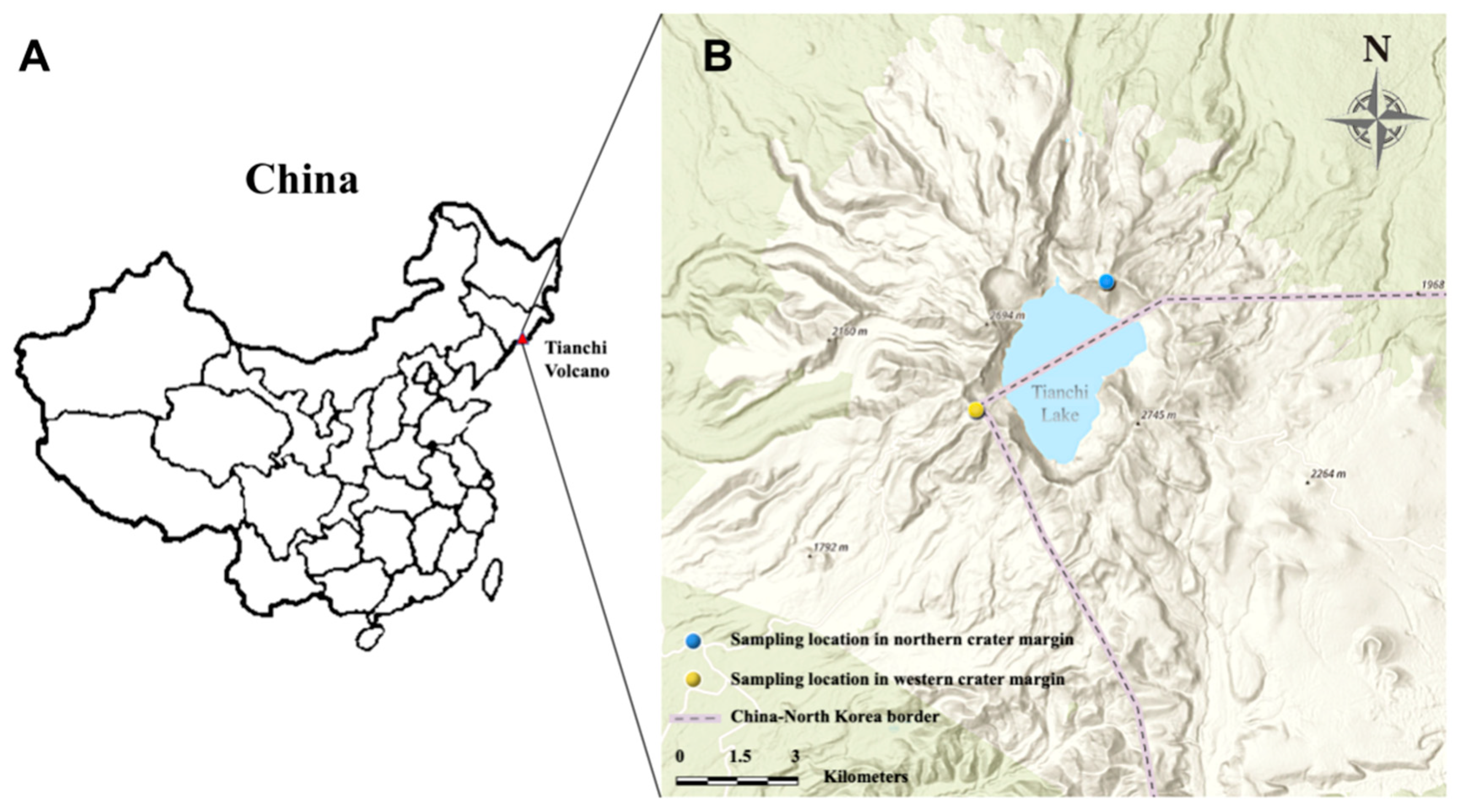
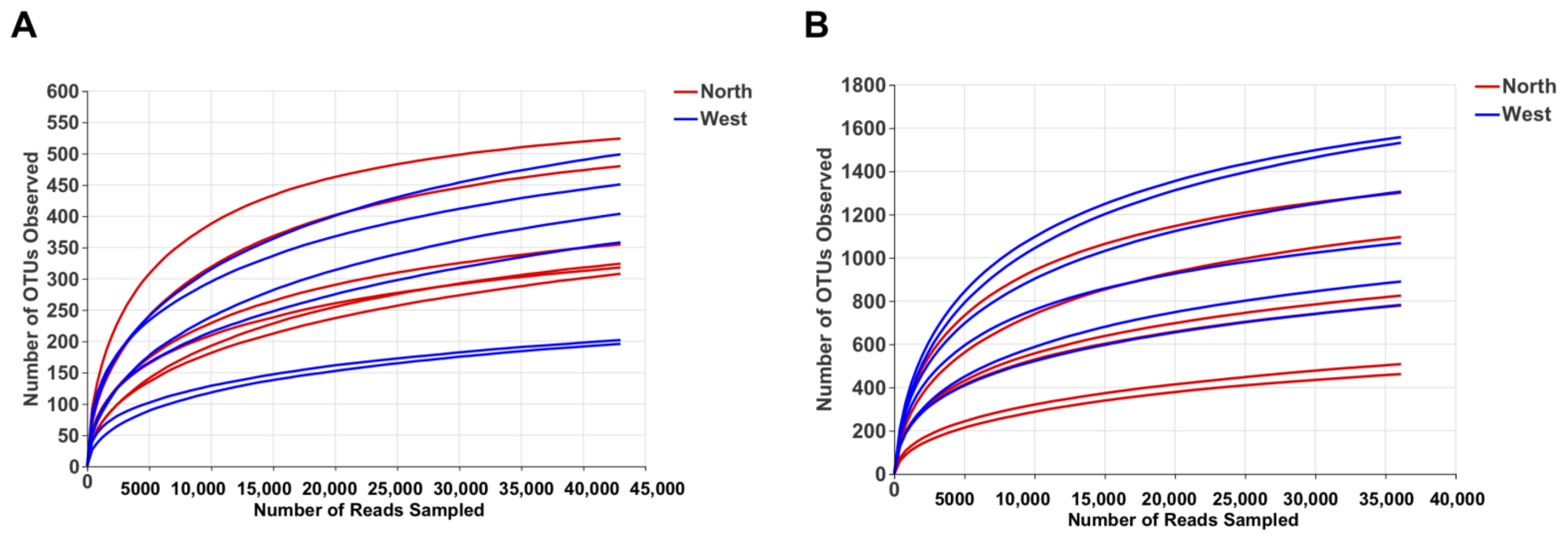
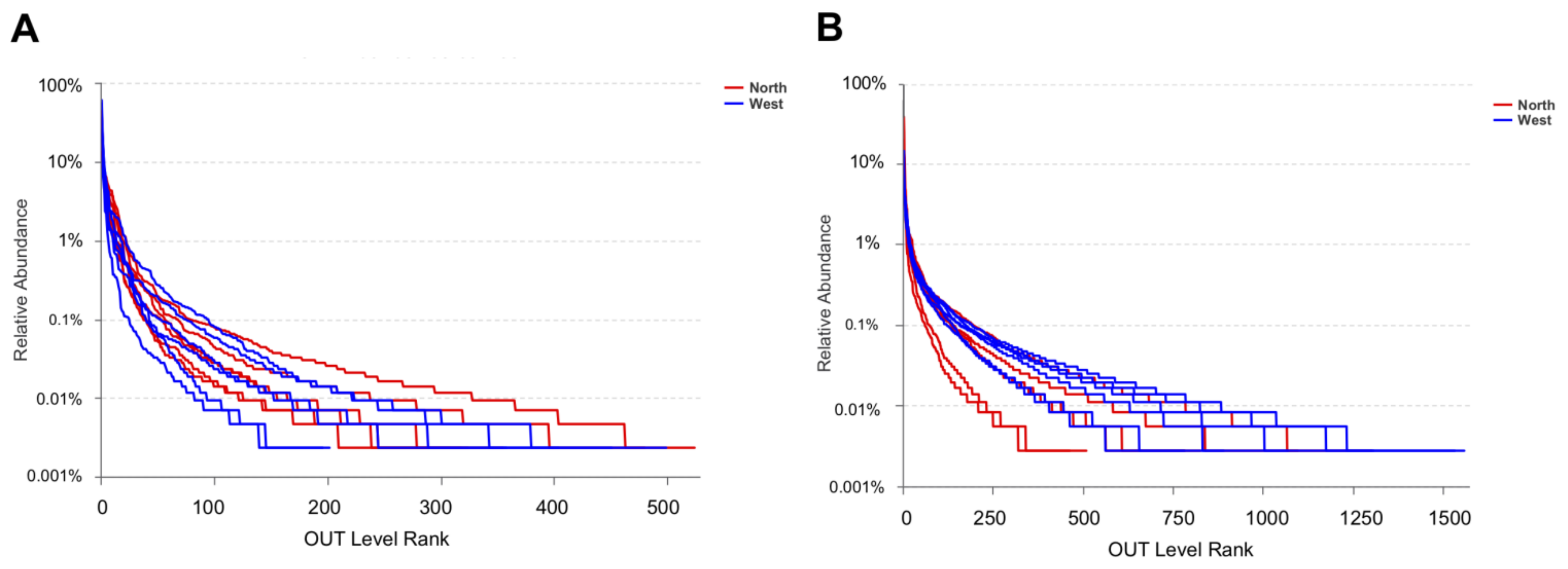
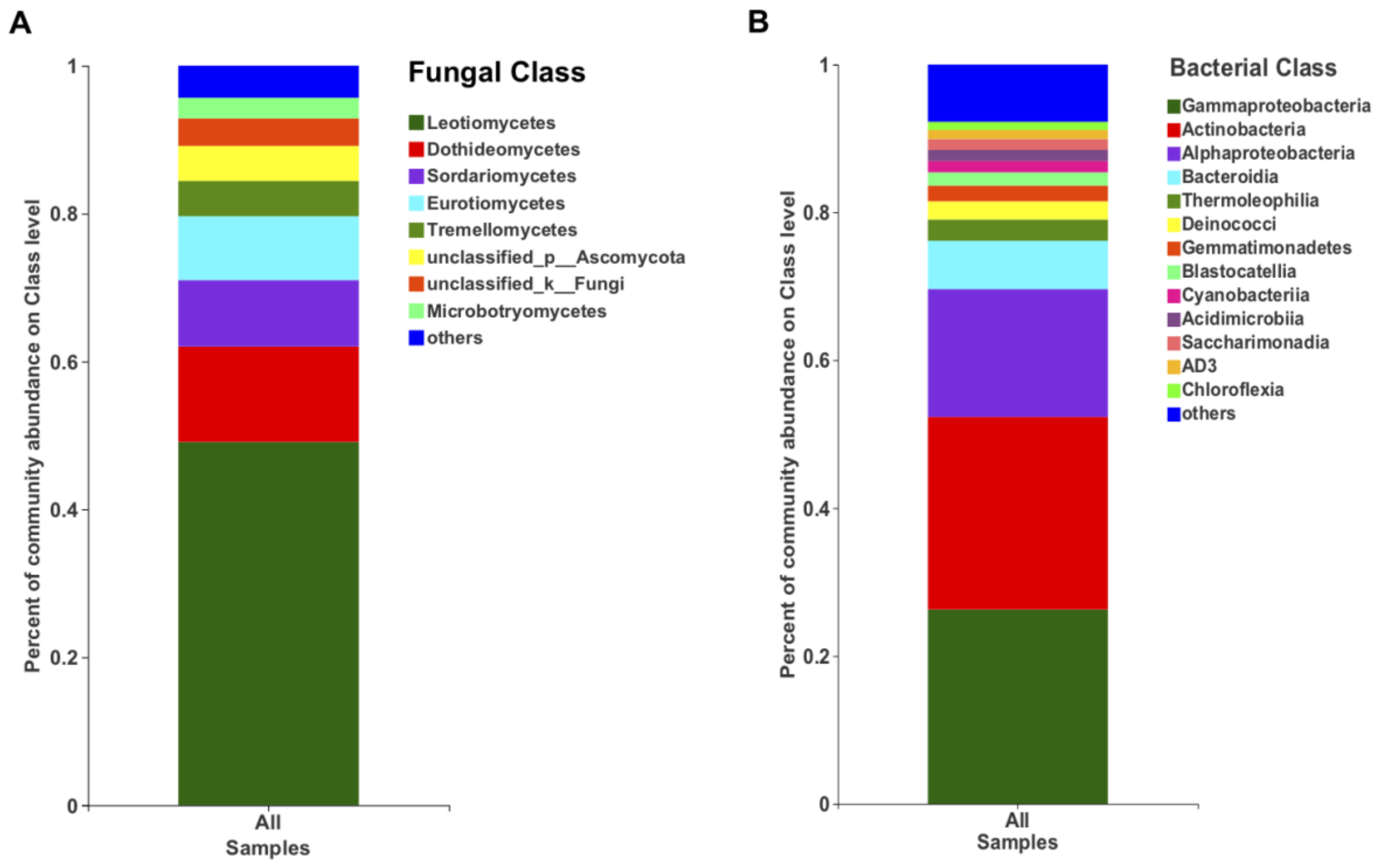
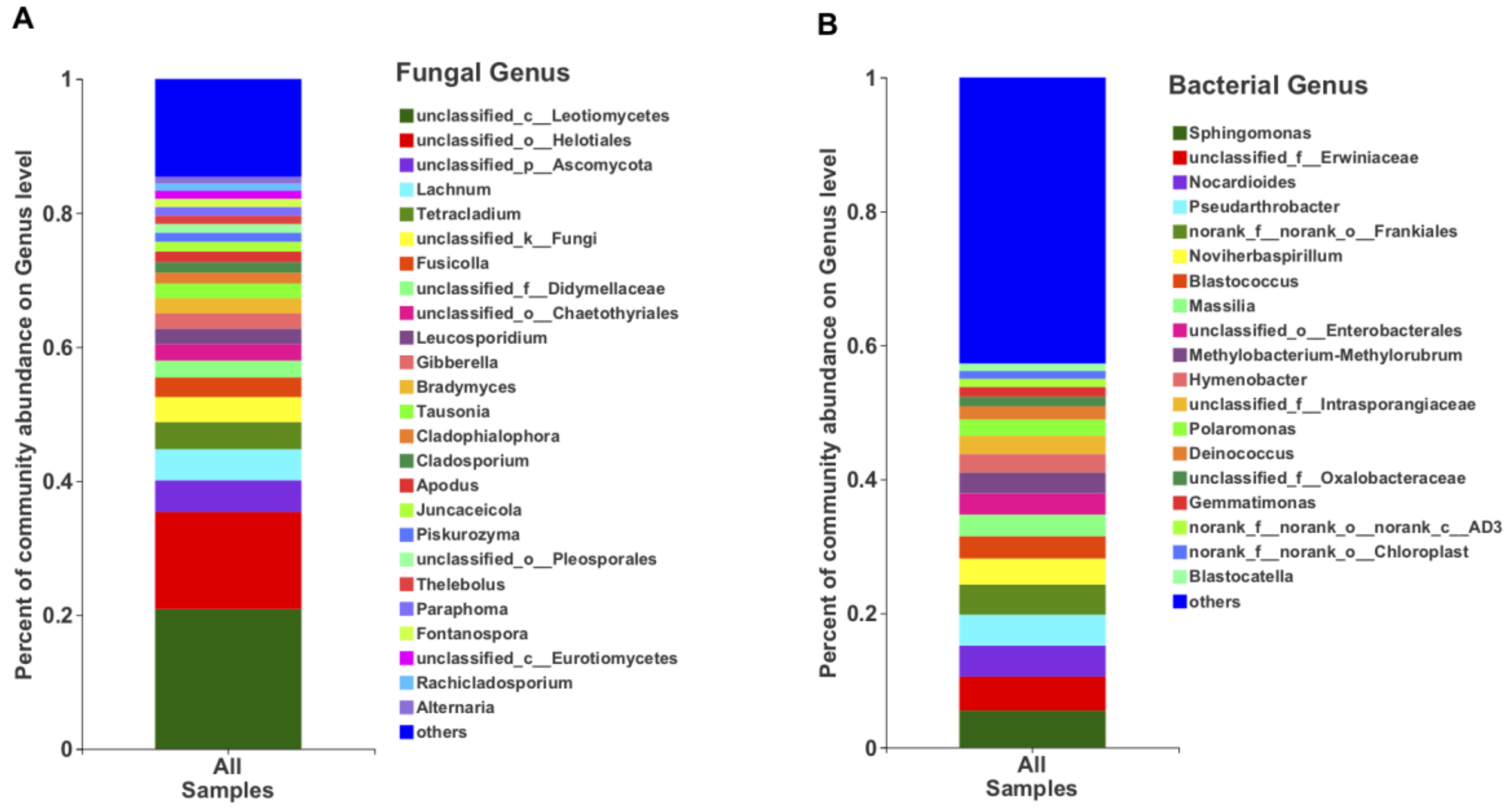
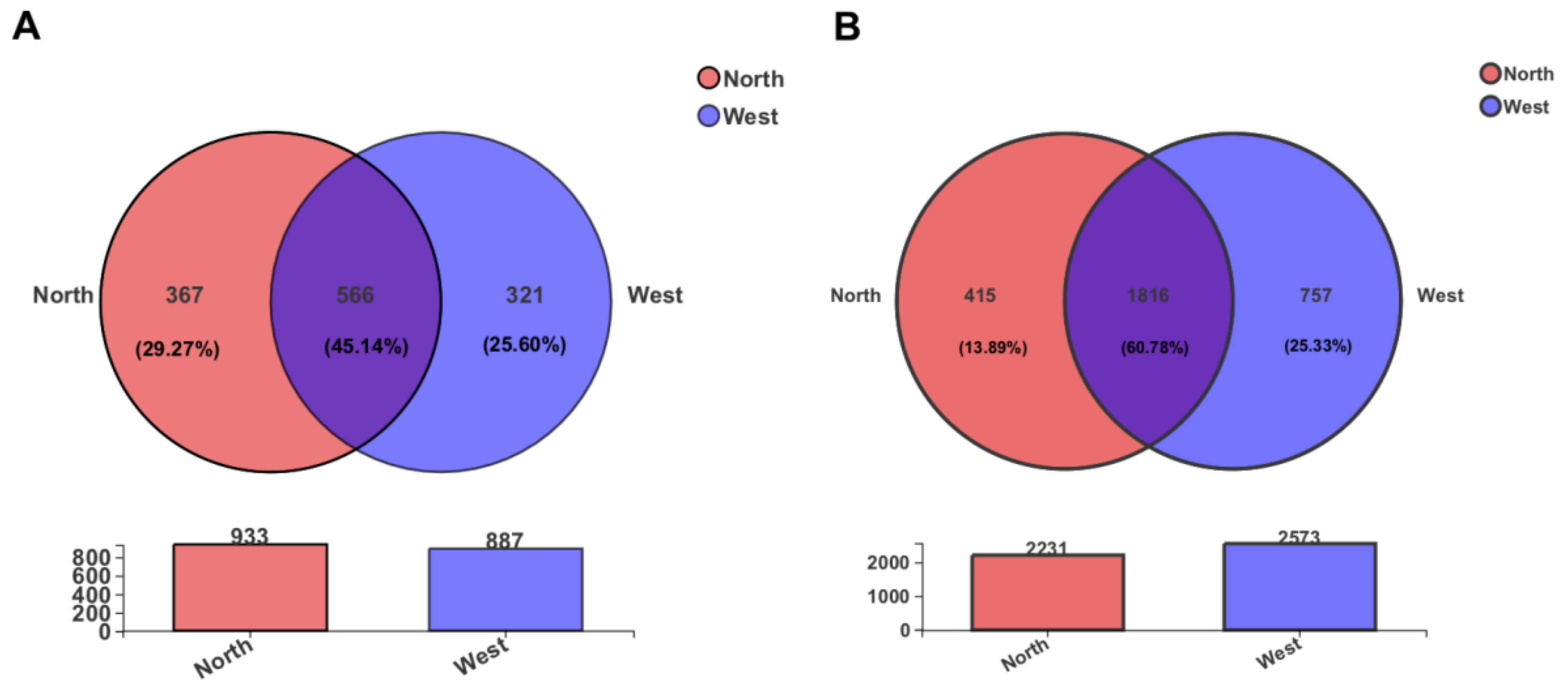


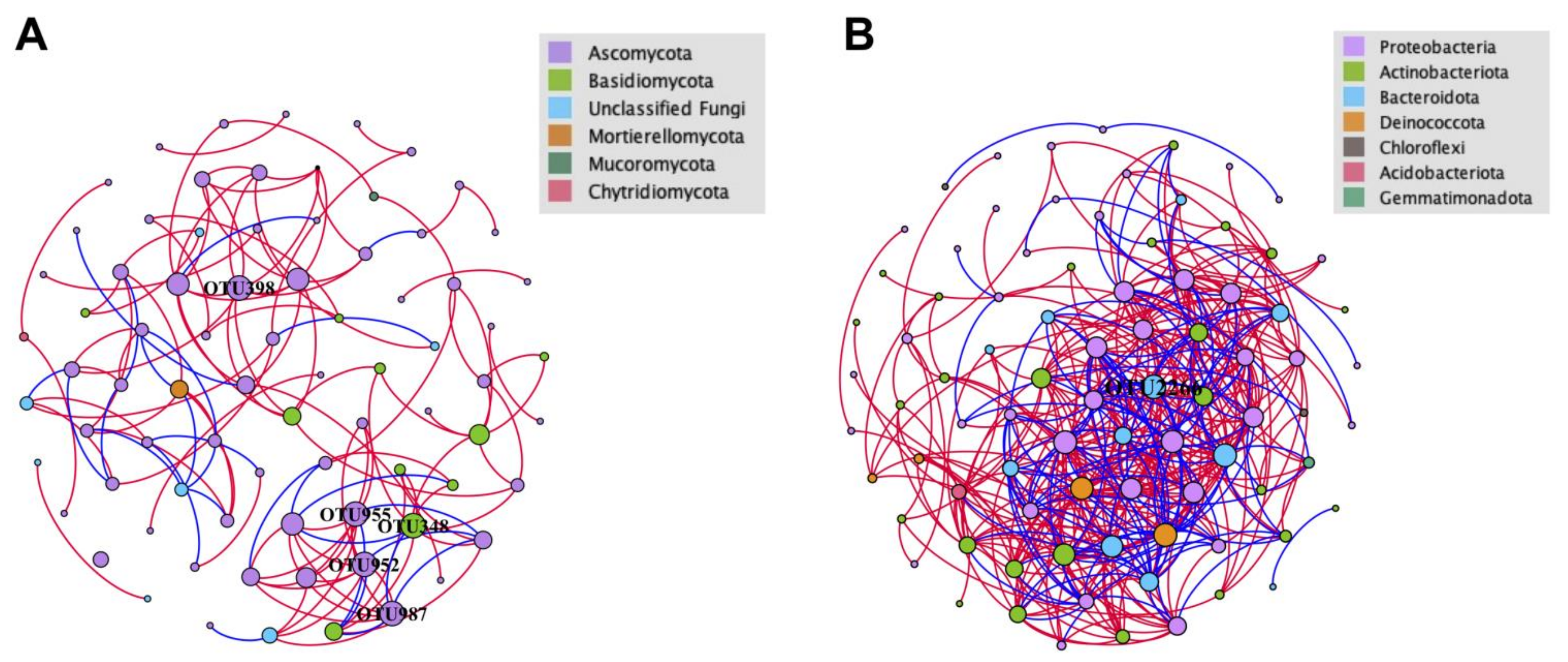
| Sampling Sites | Latitude | Longitude | Altitude (m a.s.l) | Sample Type |
|---|---|---|---|---|
| Northern margin of Tianchi crater | 42°1′33″ N | 128°4′8″ E | 2620 | 6 Soil stone mixture samples |
| Western margin of Tianchi crater | 41°59′48″ N | 128°1′44″ E | 2460 | 6 Soil stone mixture samples |
| Microbes | Locus | Primer Name | Direction | Sequence | Target Region |
|---|---|---|---|---|---|
| Fungi | Internal transcribed spacer (ITS) | ITS1 | Forward | 5′-TCCGTAGGTGAACCTGCGG-3′ | ITS |
| ITS4 | Reverse | 5′-TCCTCCGCTTATTGATATGC-3′ | |||
| Bacteria | V3 to V4 hypervariable region | U341F | Forward | 5′-ACTCCTACGGGAGGCAGCAG-3′ | 16S rRNA |
| U806R | Reverse | 5′-GGACTACHVGGGTWTCTAAT-3′ |
| Phylum | Class | Order | Genus (Number of Species) |
|---|---|---|---|
| Ascomycota | Dothideomycetes | Capnodiales | Cladosporium (4) |
| Coniosporiales | Coniosporium (1) | ||
| Dothideales | Aureobasidium (1) | ||
| Pleosporales | Alternaria (3), Curvularia (1), Didymella (4), Epicoccum (1), Juxtiphoma (1), Leptosphaeria (1), Paraphaeosphaeria (1), Paraphoma (1), Phaeosphaeria (2), Phoma (2) | ||
| Eurotiomycetes | Chaetothyriales | Exophiala (1) | |
| Eurotiales | Byssochlamys (1), Penicillium (5) | ||
| Incertae sedis | Incertae sedis | Tricellula (1) | |
| Leotiomycetes | Helotiales | Xenochalara (1) | |
| Helotiales | Helotiales sp. (1) | ||
| Saccharomycetes | Saccharomycetales | Candida (1) | |
| Sordariomycetes | Amphisphaeriales | Microdochium (1) | |
| Hypocreales | Fusarium (3), Nectria (1), Tangerinosporium (1), Trichoderma (5) | ||
| Microascales | Cephalotrichum (1) | ||
| Xylariales | Xylaria (1) | ||
| Basidiomycota | Microbotryomycetes | Leucosporidiales | Leucosporidium (1) |
| Tremellomycetes | Cystofilobasidiales | Tausonia (1) | |
| Tremellales | Naganishia (1) | ||
| Mucoromycota | Mucoromycetes | Mucorales | Mucor (1) |
| Sample | Fungal Community | Bacterial Community | ||||||
|---|---|---|---|---|---|---|---|---|
| OTU Numbers | Shannon | Chao | Coverage (%) | OTU Numbers | Shannon | Chao | Coverage (%) | |
| Mean ± SD | 368 ± 108 | 2.95 ± 0.74 | 446.14 ± 108 | 99.8 ± 0.1 | 1009 ± 365 | 4.72 ± 0.93 | 1240.98 ± 393.60 | 99.3 ± 0.2 |
| N1 | 324 | 2.36 | 395.67 | 99.8 | 462 | 2.59 | 607.01 | 99.6 |
| N2 | 480 | 3.45 | 526.36 | 99.8 | 508 | 3.38 | 707.94 | 99.5 |
| N3 | 308 | 2.44 | 426.32 | 99.8 | 825 | 4.78 | 1061.35 | 99.4 |
| N4 | 355 | 3.35 | 412.37 | 99.8 | 782 | 4.62 | 1049.14 | 99.4 |
| N5 | 318 | 3.42 | 397.44 | 99.8 | 1096 | 4.84 | 1297.27 | 99.3 |
| N6 | 524 | 4.04 | 555.52 | 99.9 | 1301 | 5.58 | 1481.06 | 99.3 |
| W1 | 499 | 3.20 | 588.25 | 99.7 | 1558 | 5.75 | 1828.56 | 99.1 |
| W2 | 404 | 3.01 | 496.64 | 99.7 | 1068 | 5.22 | 1326.74 | 99.3 |
| W3 | 451 | 3.86 | 554.26 | 99.7 | 1306 | 5.44 | 1569.18 | 99.2 |
| W4 | 358 | 2.34 | 477.28 | 99.7 | 1532 | 5.47 | 1840.95 | 99.0 |
| W5 | 196 | 1.54 | 255.11 | 99.9 | 890 | 4.49 | 1101.68 | 99.3 |
| W6 | 202 | 2.39 | 268.5 | 99.9 | 780 | 4.52 | 1020.9 | 99.4 |
| Network Metrics | Community | |
|---|---|---|
| Fungi | Bacteria | |
| Number of nodes | 77 | 84 |
| Total number of edges | 136 | 426 |
| Number and percentage of positive correlations | 108 (79.41%) | 302 (70.89%) |
| Number and percentage of negative correlations | 28 (20.59%) | 124 (29.11%) |
| Average degree | 3.487 | 10.143 |
| Network diameter | 12 | 7 |
| Modularity | 0.709 | 0.341 |
| Number of communities | 14 | 10 |
| Average clustering coefficient | 0.521 | 0.565 |
| Average path length | 4.982 | 2.661 |
Publisher’s Note: MDPI stays neutral with regard to jurisdictional claims in published maps and institutional affiliations. |
© 2021 by the authors. Licensee MDPI, Basel, Switzerland. This article is an open access article distributed under the terms and conditions of the Creative Commons Attribution (CC BY) license (http://creativecommons.org/licenses/by/4.0/).
Share and Cite
Wang, X.; Pecoraro, L. Analysis of Soil Fungal and Bacterial Communities in Tianchi Volcano Crater, Northeast China. Life 2021, 11, 280. https://doi.org/10.3390/life11040280
Wang X, Pecoraro L. Analysis of Soil Fungal and Bacterial Communities in Tianchi Volcano Crater, Northeast China. Life. 2021; 11(4):280. https://doi.org/10.3390/life11040280
Chicago/Turabian StyleWang, Xiao, and Lorenzo Pecoraro. 2021. "Analysis of Soil Fungal and Bacterial Communities in Tianchi Volcano Crater, Northeast China" Life 11, no. 4: 280. https://doi.org/10.3390/life11040280
APA StyleWang, X., & Pecoraro, L. (2021). Analysis of Soil Fungal and Bacterial Communities in Tianchi Volcano Crater, Northeast China. Life, 11(4), 280. https://doi.org/10.3390/life11040280







